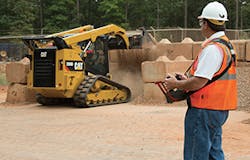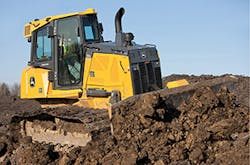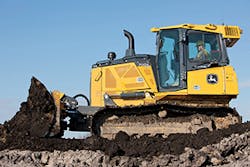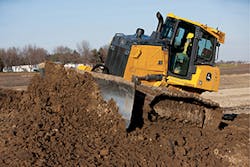From GX May 2016
The use of robotic technology is growing in the construction and grading industry, and this new wave of machines and software has already brought radical changes to a wide variety of operations. From driverless vehicles, to three-dimensional (3D) machine control, to surveying and 3D modeling, the age of robots is no longer science fiction. And it’s no longer just for the big guys. Advances in designs and marketplace acceptance are making these products more accessible to medium and small contractors.
Before we take a look at the progress and impact of robots, let’s make sure we’re agreed upon a definition for this discussion. For our purposes, we’ll use the Oxford Dictionary’s definition of robot: “A machine capable of carrying out a complex series of actions automatically, especially one programmable by a computer.” Using Oxford’s definition, it’s easy to point out the use of robots all around us. In commercial use, they’re well established in both heavy and light manufacturing, and on the consumer side, there are common household products such as robot vacuum cleaners, and not so common products, such as wearable robotic exoskeletons that help paraplegics stand and walk. We could cite countless examples, but when it comes to the grading and construction industry, other than 3D grading control, robotics has struggled to attain mainstream status. But that’s changing.
Due in large measure to advances in related industries, such as mining and agriculture, robot technology is well established for autonomous vehicle operations. For example, in the agricultural tractor sector, there’s the electric Spirit hay mower, by Autonomous Tractor, and the Grizzly, an all-terrain autonomous smart tractor from Clearpath Robotics, which offers sensors that can detect soil conditions and apply treatments. The ASI Forge Robotic Platform looks like a typical skid-steer vehicle, and it can accommodate over 100 attachments for both farming and construction tasks. ASI also offers hardware and software components to convert farm tractors, dozers, and other construction vehicles to robotic controlled vehicles. These examples represent a range of sizes comparable to a small skid-steer on up to a large farm tractor, but as we’ll see from looking at the mining industry, size is no limitation for robotic controls.
For many years, the heavy equipment industry has been manufacturing robotics for the mining industry in the form of autonomous vehicle control. Some recognizable names include Caterpillar and Komatsu. Cat offers Command for Hauling, a system that uses sophisticated technologies to enable Cat autonomous haul trucks to work safely and productively on busy mine sites. Advanced safety systems enable these autonomous haul trucks to operate reliably around other mining equipment, light vehicles, and onsite employees.
Caterpillar is also addressing safety in construction with an innovative system that isn’t autonomous, but does remove the operator from the machine. In late 2015, Caterpillar and TORC Robotics, Blacksburg, VA, announced the launch of RemoteTask, a remote control system for Cat D-Series skid-steer, multi-terrain, and compact track loaders. The RemoteTask system enables operators to precisely control the machines from outside the cab—as far away as 1,000 feet for safe distance operations around potentially hazardous tasks and environments.
Transforming a machine takes about an hour for a Cat dealer. RemoteTask lets the machine transition from manual to remote mode at the turn of a key switch. The portable console allows the operator to move as needed for good lines of sight. RemoteTask integrates into 16 models of Cat D Series skid-steer, multi-terrain, and compact track loaders and can control more than 200 work tools with all hydraulic functions accessed via the remote system.
Addressing the safety of robotic machines continues to be a major theme in developing fully autonomous equipment for the grading and construction industry, according to Brian Rauch, senior vice president, engineering, manufacturing and supply management, John Deere. “With mines and quarries, it’s a situation where the company is working the same location. But there’s also a higher level of complexity than a farm, because you don’t exactly do the same work at the same spot every day. Yet it’s similar to a farm, where you have a limited number of people in the workspace area. The typical construction space is different. It’s not unusual to see a number of different machines at the job site working at the same time and a lot of people around them.”
As the number of people on a job site rises, so too does the potential for accidents. However, there are some solutions (both old and new) to keep workers and equipment safe. On the tried and proven side of the ledger, there’s proximity warning technology, such as the Armour System, from Scan-Link Technologies Ancaster, Ontario, Canada. The system uses RFID (radio-frequency identification) to detect people and objects that are too close to a heavy vehicle. In addition to detecting people, the obstacle detection can alert the operator of the vehicle when they approach specially marked inanimate objects, such as static infrastructure, including pipes, vents, transformers, and open pits. Scan-Link also offers its Safe-Zone Sentinel, to determine that all members of a group of people are accounted for within a small zone or region.
On the newest and latest technology side of the ledger, SRI International, Menlo Park, CA, has developed a real-time, sensor system for stationary and dynamic object detection, pedestrian classification, and tracking capabilities from a moving unmanned ground vehicle (UGV). The system is designed to operate on a UGV traveling up to 25 miles per hour, under day and night conditions, and on primary and secondary roads. It can also detect and track pedestrians up to 50 meters away.
Fifty meters is about 492 feet, which just happens to fall under the vertical height limitation of 500 feet, set by the Federal Aviation Administration for unmanned aerial vehicles, more commonly referred to as UAVs, or drones. Considering the rapid advancements in object detection, it would seem conceivable that drones could use the technology to ensure worker safety at a job site with autonomous vehicle operations. In fact, drones are already being used for other purposes in conjunction with autonomous construction vehicles.
In late-2015, heavy equipment manufacturer, Komatsu, announced that its Smart Construction service had adopted drone technology from Skycatch, San Francisco, CA, to automate heavy equipment operations at job sites. Benefits include drone-supplied surveys for 3D models, and accurate monitoring of material handling by heavy equipment, which leads to higher efficiency. To date, Skycatch drones have been paired with Komatsu dozers and excavators equipped with the company’s intelligent Machine Control (iMC) technology.
Initially, operations have been limited to semi-automatic functionality, but Komatsu has announced its intentions to remove operators from the equipment. Another unique aspect of the business proposition is Komatsu’s plans to lease the machine/drone packages to customers, and handle their operation. So far, trials for the concept have been limited to Japan.
From a perspective of real-time data usage in construction, the contribution of Skycatch demonstrates more than just its drone capabilities. The company sees its drones as tools integrated with computer aided design (CAD) and building information management software. Together, these technologies allow personnel to share and collaborate on a project’s real-time progress.
With high-resolution recurring imagery from a drone, a company has photographic evidence that helps to mitigate risk. Additionally, accurate 2D measurements and 3D volumetric tools replace manual estimates, and that helps to reduce delays, rush orders costs, and excess inventory. Moreover, project managers can use stockpile verification and monitoring of volumetric change to control assets and minimize billing discrepancies. For safety supervisors, there’s the ability to combine coordinates and day-to-day imagery to monitor spills and detect unreported hazards.
Ultimately, we’re seeing the evolution of the next phase of 3D machine control, where drones complete surveys autonomously, software creates 3D models of the surveyed terrain, and the project’s 3D model is overlaid on the terrain model. Then, real-time site data is combined with 3D machine control on grading, excavation, and construction equipment that uses GPS to guide their movements, as they execute the specifications of the project.
If the description of the process above leaves you wondering about how complicated it is to adopt this technology, we have a two-part answer: No, we’re not yet to the point of being “plug and play.” However, machine control technology is much easier to adopt and use than it was in the past, much less expensive, and much more accessible to midrange and small contractors. In fact, in late-2015, Trimble, Sunnyvale, CA, introduced a 3D grade control solution for Bobcat all-wheel steer loaders, compact track loaders, and skid-steer loaders.
When we see 3D machine control technology available for smaller machines such as a Bobcat, does it indicate more of a mainstream distribution and adoption in the marketplace?
“Absolutely,” says Scott Crozier, business area manager for Trimble’s Site Positioning and Small Site Contractor Products. “We’re seeing an increase in small contractors that are becoming aware of the technology or doing more work with larger contractors that are using the technology, and they’re seeing the benefits. I also think that office software products and data services for 3D modeling has become a lot more accessible, whereas five or 10 years ago it was more of a challenge to find the skills to build a 3D model from paper plans.”
To make it easier to adopt 3D machine control, Trimble has simplified the required GNSS infrastructure for use on small sites. “We’ve come up with some easy options to allow contractors to use a base station as the primary infrastructure on small jobs where they might not need all the radio infrastructure,” says Crozier. “There’s also an option to use a Wi-Fi base station with our product so that GPS corrections are actually communicated over a Wi-Fi link to the machine. Although it has somewhat of a limited range, it’s perfect for small projects because they don’t require the machines to go miles and miles away from the base station.”
In a related effort to simplify 3D modeling, Trimble now distributes a branded version of ClearEdge 3D’s EdgeWise software. The EdgeWise software uses automated feature extraction and modeling to significantly reduce the time required for professionals to generate CAD models of pipes, conduit, structural steel, and gridded concrete from data captured with 3D laser scanners. In combination with Trimble’s laser scanning instruments and Trimble RealWorks software, EdgeWise provides a complete workflow. The system can provide as much as a 50% time savings for professionals engaged in data collection, point cloud registration, and editing and final modeling for industrial and building construction applications.
TORC Robotics and Cat teamed up to offer the “Remote Task” system.
Trimble has also been advancing its technology beyond 3D machine control. For compactors, there’s tracking software, so when multiple machines are rolling a particular section of asphalt or subgrade of a road, the operators can see each other’s maps and share the data, to prevent repeat work. For milling and concrete paving, Trimble offers products that steer the milling machine and the paver to a predefined linear element inside the design model. “If you have a curb line defined inside the 3D design model, our machine control product will steer the machine to that line horizontally, with accuracy down to millimeters,” says Kevin Garcia, business area manager for Trimble’s Paving Products. “Concrete pavers and milling machines only travel about three feet per hour; so on the paving side the increase of automation that includes controlling the drum, and steering is more accepted, because they don’t move very fast.”
A John Deere 700K equipped with SmartGrade grade control
The use of software is a great example of integrating and analyzing 3D data, but now we’re also seeing new features in software and telematics for analyzing data for machine maintenance. For example, John Deere’s JDLink has evolved into more than just a machine monitoring system. “Most systems on the market today have a one-way connection, but ours has a two-way connection,” says Brian Rauch. “So, you get information that provides a location and key statistics on the machine. Of course, everybody in the industry provides hours, fuel consumption, idle time, and about a dozen other things that are industry standards. We do more than that with a feature called Service Advisor Remote. It’s our ability to read the electronics remotely, and with our two-way communication we can also download and install as well. So we have a cellular connection and the GPS location of the machine, and we can get all of the data and performance information and give it to the customer in a way that is readily accessible from www.MyJohnDeere.com, or download it to their own system.”
While telematics and machine monitoring are mainstream offerings on modern equipment, what about all the older machines still working in the field that were built before telematics were common? Happily, there are some solutions, such as the ST-576-M, an RFID engine meter that captures and securely transmits data for use in maintenance planning, service, and utilization data, from OEM Data Delivery, Shelton, CT.
“Not everybody runs a fleet that’s newer than 2007,” says Luke Manney, project manager. “And of course, equipment gets broken and can become inaccurate. So we can put a service tracker on the machine, and it captures the hours of runtime and sends it to our website. It also has a button on it to track fuel volumes. That’s important for those typical arrangements where you see of all machines lined up at the end of the day, and a fuel truck driver has to move from one machine to the next. He’s supposed to write down the fuel volumes, but instead he can press a service tracker button, and it connects to the device on the fuel truck and identifies the equipment and the volume of fuel. Now all this data is sent back to the office in a useful form, and it’s accurate.”
Accurate data saves time in the back office, and can be a key factor in winning bids. “There are two factors that influence the cost per hour that you charge yourself for your asset,” explains Manney. “One of them is fuel, and the other one is utilization. Getting that information from the field when you have something like 100 assets can be daunting. So we have automated that process as to how much fuel went into the machine on any given day. With data on what work it did, you can figure out your fuel efficiency. And then, by collecting the hours of work it did in a year, you can calculate how much you should be charging yourself per hour.”
So far, we’ve talked about the impact of robotics for grading, digging down, and moving materials, but what about the process of building up? In the past decades, construction hasn’t seen a lot of progress in the area of robotic building, but that has changed, thanks to SAM, a truly revolutionary robot from Construction Robotics, Victor, NY. SAM is a semi-automatic mason that has the potential to reinvent the world of masonry and bricklaying. It’s quite a revelation to watch a video of SAM as its robotic arm picks up a brick, layers it with mortar, and deftly places it in a wall.
According to Scott Peters, president and cofounder of Construction Robotics, the software that guides SAM demonstrates some major breakthroughs in technology. “We created this brick mapping software where we can actually lay out walls perfectly on bond, and determine exactly where the locations are in theworld,” says Peters. “It allows you to correct for real onsite conditions with just a few simple measurements. Then we correct the whole structure so the brick locations aren’t just theoretical anymore—they are actually based on dimensions and the constraints of the project.”
John Deere’s SmartGrade helps operators.
As an example of the benefits of the software’s pre-planning and layout functions, its computer graphics can show a customer how a wall or structure would look with a variety of patterns and brick colors, or how a company logo would look if executed with bricks. “We have software to import logos, and if you think of bricks, they’re like pixels on the screen,” says Peters. “We’re also able to calculate in advance how many cut bricks would be needed and how long it would take to actually build the wall. So we’re able to give them all this information up front, which is something that you can’t get from a manual process.”
In the past, the manual process for laying out a complicated job with many windows and doors was a time consuming task for masons. Traditional methods required hours of measurements and calculations to figure out the specifications for cutting bricks to make everything fit. “After watching the masons workthrough this process, we demonstrated our software on a laptop with a visual of the wall map we created for the robot,” says Peters. “In a matter of a few minutes we ran through a number of iterations of how to lay the wall out. Instead of using a two-inch cut sliver of a brick next to a full brick, we were able to lay out the wall differently, so that it looked better, and it also required less cuts—and was more friendly to lay. It’s like comparing a pencil and paper, versus a calculator. It allows you to plan for better productivity and efficiency on the job site.”
Grading is made easier with John Deere’s SmartGrade technology.
With the success of SAM, Peters is ready to advance his company’s software and technology in new construction arenas. “We see potential in the construction space and understand the practicalities and intricacies. If you look at some of the advancements of related technologies—such as lasers, smartphones, and prefabrication—you see potential for a lot more technology and advancements. In our opinion, a lot of these opportunities are not totally new thinking. They’re transitional from other manufacturing industries that have used them for years. So the question is how to apply them in the right way, because it’s not a factory environment indoors. It’s very dynamic, but still some of these principles can translate nicely.”
Looking at the current state of robotic technology, it appears that the stage is set for a rapid transition Peters speaks of. We already have autonomous vehicles operating in mining, agriculture, and surveying. And the use of 3D blade control can legitimately be described as autonomous, although the dozers and graders using them still have operators at the controls. But just as Komatsu plans to use drones to monitor autonomous excavator operations at a construction site, can it be long before that technology is applied to grading? Certainly, the technology exists to overcome worries about onsite workers around autonomous machines. So yes, the construction industry has entered the age of robots. They’re here to stay, and as their software continues to grow in sophistication, we’ve only just begun to see what they can do.







